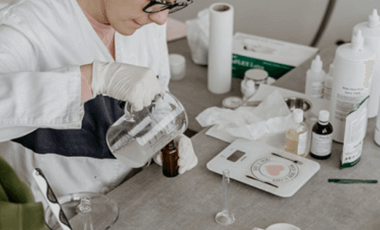






Are alcohol-free hand sanitizers effective?
Alcohol-free hand sanitizers are effective in reducing microbes. And what are microbes? They are tiny living things that are found all around us and are too small to be seen by the naked eye, most common types are actually bacteria, viruses and fungi.
How do they work?
What are some of the active ingredients used in alcohol-free hand sanitizers? Some regularly used disinfectants are Benzalkonium Chloride (BKC), Didecyl Dimethyl Ammonium Chloride (DDAC), Dioctyl Dimethyl Ammonium Chloride (DODAC) and Chloroxylenol (PCMX). And out of these four compounds, three are quaternary ammonium compounds (QACs) namely BKC, DDAC and DODAC. (Read more about QACs in another article we have written here) Briefly, QACs are active towards vegetative bacteria, enveloped viruses and most yeast and moulds. They are membrane active agents and have a similar mechanism to alcohols where they disrupt the lipid structure of the viral envelope. The COVID-19 virus is actually an enveloped virus, so QACs is an active disinfectant towards it!
Summary of the commonly used active ingredients
| Disinfectant | Description |
| BKC | BKC is a common alternative to alcohols in alcohol-free hand sanitizers. It offers strong detergency and rapid, safe, powerful antimicrobial activity at low concentrations.
BKC based disinfectants are non-toxic, non-tainting, non-corrosive, non-staining and odour-free at use dilutions. |
| DDAC | DDAC are used in many biocidal applications. It can reduce microbes; however, they are less effective in killing germs compared to alcohols and require a longer contact time to show significant effect. Hence, they are typically used as disinfectants in surface disinfecting products. |
| DODAC | Similar to DDAC, DODAC is a broad-spectrum disinfectant that requires longer contact time to kill germs.
It has been used in human and instrument sensitization and industrial applications. Furthermore, it can be used as disinfectant cleaner for linen, recommended for use in hospitals, hotels and industries. |
| PCMX | PCMX is another alternative. PCMX is a halogen-substituted phenolic compound that is widely used as preservatives in cosmetics and active agents in anti-microbial soaps.
Similar to QACs, PCMX is also poorer than alcohols but is effective in reducing microbes to a certain extent. |

Of course, as compared to an alcohol-based hand sanitizer, an alcohol-free hand sanitiser has a slower speed of action and is only effective to a certain extent. However, alcohol-free hand sanitiser are milder to the skin and does carry a strong stench!

Many common household cleaning products that we get from the supermarkets contain chemicals that can harm your body. Learn what products to avoid and what you can do!
Note: HTML is not translated!